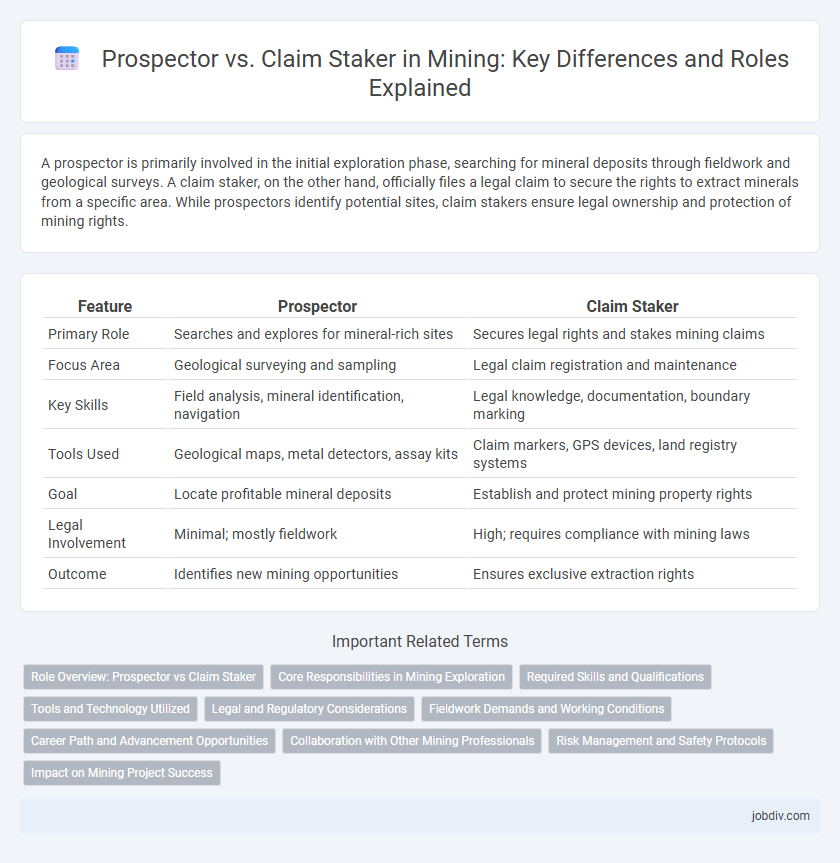A prospector is primarily involved in the initial exploration phase, searching for mineral deposits through fieldwork and geological surveys. A claim staker, on the other hand, officially files a legal claim to secure the rights to extract minerals from a specific area. While prospectors identify potential sites, claim stakers ensure legal ownership and protection of mining rights.
Table of Comparison
| Feature | Prospector | Claim Staker |
|---|---|---|
| Primary Role | Searches and explores for mineral-rich sites | Secures legal rights and stakes mining claims |
| Focus Area | Geological surveying and sampling | Legal claim registration and maintenance |
| Key Skills | Field analysis, mineral identification, navigation | Legal knowledge, documentation, boundary marking |
| Tools Used | Geological maps, metal detectors, assay kits | Claim markers, GPS devices, land registry systems |
| Goal | Locate profitable mineral deposits | Establish and protect mining property rights |
| Legal Involvement | Minimal; mostly fieldwork | High; requires compliance with mining laws |
| Outcome | Identifies new mining opportunities | Ensures exclusive extraction rights |
Role Overview: Prospector vs Claim Staker
A prospector primarily explores potential mining areas by conducting geological surveys and sampling to identify mineral deposits. A claim staker legally registers land to secure mining rights, ensuring exclusive access and protection under mining laws. While prospectors focus on discovery, claim stakers are responsible for formalizing ownership and maintaining claims against rival interests.
Core Responsibilities in Mining Exploration
Prospectors primarily focus on identifying mineral-rich areas through geological surveys and sampling to assess the potential of mining sites. Claim stakers are responsible for legally securing mining rights by marking and registering claims to protect mineral deposits for future extraction. Both roles are essential for establishing control over valuable mining territories and ensuring compliance with mining regulations.
Required Skills and Qualifications
Prospectors require strong geological knowledge, field navigation skills, and experience in mineral identification to locate potential mining sites effectively. Claim stakers need expertise in legal regulations, surveying techniques, and land management to accurately define and secure mining claims. Both roles demand physical endurance and attention to detail to ensure successful exploration and claim establishment.
Tools and Technology Utilized
Prospectors rely heavily on portable tools such as hand-held metal detectors, GPS devices, and panning equipment to identify mineral-rich areas in remote locations. Claim stakers utilize more sophisticated technology including surveying instruments, drones for topographical mapping, and GIS software to accurately mark and document mining boundaries. Both roles integrate digital tools with traditional methods, but claim stakers emphasize precision and legal documentation while prospectors focus on initial discovery and sample collection.
Legal and Regulatory Considerations
Prospectors must secure exploration permits and comply with environmental regulations before sampling, ensuring initial mineral discovery aligns with local mining laws. Claim stakers hold legally recognized rights to a mining area after officially registering the claim with governmental authorities, enabling them to extract and develop resources following specific statutory requirements. Both roles require adherence to regional mining codes, land use policies, and reporting obligations to maintain claim validity and avoid legal disputes.
Fieldwork Demands and Working Conditions
Prospectors face intensive fieldwork demands, often spending extended hours navigating remote, rugged terrains to locate mineral deposits, requiring skills in geological mapping and sampling. Claim stakers operate under physically challenging conditions as well, focusing on legally marking and documenting mining claims, which involves traversing uneven landscapes and enduring extreme weather conditions. Both roles demand stamina and resilience, but prospectors engage more in discovery-focused activities, while claim stakers emphasize legal and regulatory compliance in the field.
Career Path and Advancement Opportunities
Prospectors typically begin their careers by conducting field surveys and geological assessments to identify potential mineral deposits, gaining hands-on experience that can lead to roles such as exploration geologist or resource manager. Claim stakers focus on legally securing mining rights and ensuring compliance with regulations, often advancing to positions in land management or legal advisory within mining companies. Both career paths offer opportunities for advancement through specialization, project management, or transitioning into corporate roles in mining operations and development.
Collaboration with Other Mining Professionals
Prospectors leverage geological surveys and remote sensing data to identify promising mineral deposits, collaborating with geologists and environmental scientists to assess site viability. Claim stakers work closely with legal experts and local authorities to secure land rights and ensure compliance with mining regulations, facilitating smooth project development. Both roles benefit from interdisciplinary teamwork to optimize resource extraction and minimize operational risks.
Risk Management and Safety Protocols
Prospectors face significant risks such as unpredictable terrain and geological hazards, requiring thorough risk assessments and adherence to safety protocols like wearing protective gear and carrying emergency communication devices. Claim stakers must prioritize legal safety and accurate boundary identification to prevent disputes while managing physical risks through routine site inspections and hazard mitigation. Both roles benefit from comprehensive training in safety procedures and regular updates on regulatory compliance to minimize accidents and ensure operational security.
Impact on Mining Project Success
Prospectors play a crucial role in identifying high-potential mineral deposits, which directly influences the viability and success of mining projects. Claim stakers secure legal rights to these mineral-rich lands, ensuring exclusive access and protection against competing interests. The synergy between effective prospecting and timely claim staking significantly increases the likelihood of profitable extraction operations and long-term project success.
Prospector vs Claim Staker Infographic

 jobdiv.com
jobdiv.com